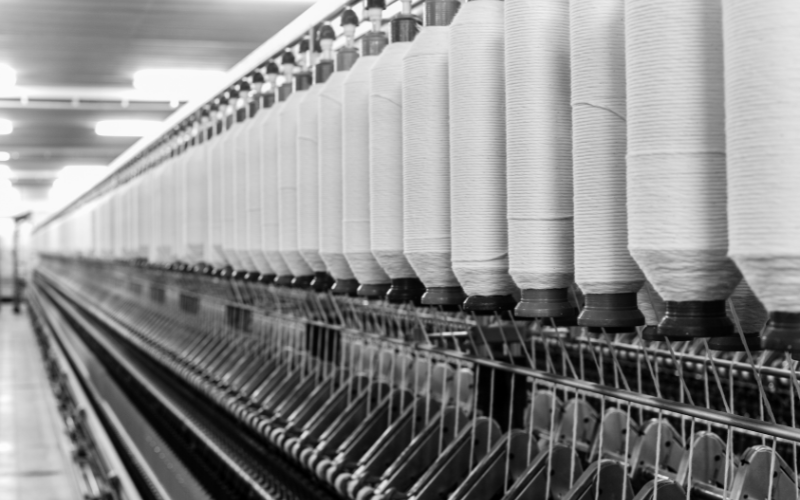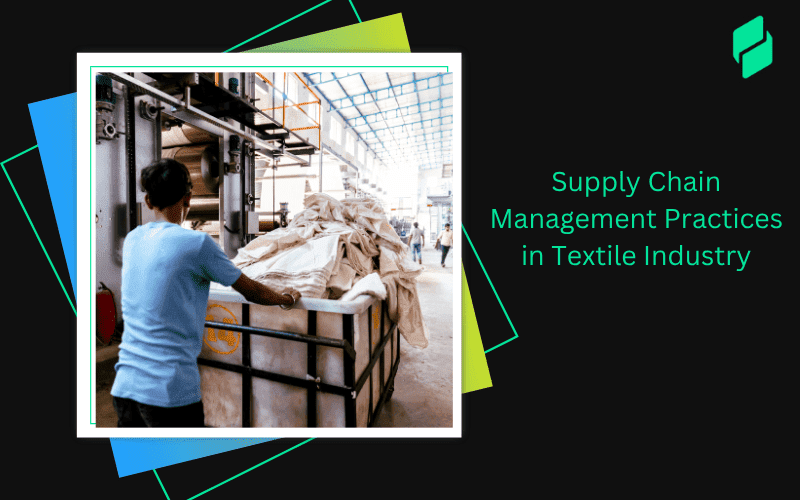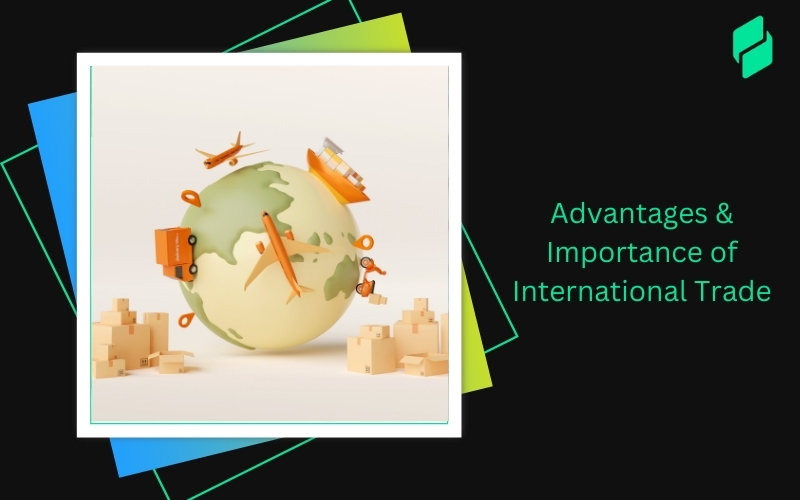Optimize your business: use unlimited savings with Pazago fulfilled now!
Get Started ->The textile industry is one of the largest and most complex sectors globally, involving a wide range of processes from sourcing raw materials to delivering finished products to consumers.
Efficient supply chain management (SCM) is crucial for maintaining competitiveness, reducing costs, and ensuring timely delivery. The industry's growth, combined with increasing demand for sustainable and ethically produced goods, has placed greater emphasis on optimizing supply chains.
According to a report, the global textile and apparel industry was valued at $1.79 trillion in 2024 and is expected to grow by 4.4% annually.
This highlights the pressing need for effective SCM practices that can adapt to the dynamic challenges of the textile market, from raw material sourcing to manufacturing and logistics.
In this blog, we will discuss key supply chain management practices in the textile industry and explore strategies for improving efficiency and sustainability.
Modern Technology in Textile Supply Chain Management

The textile industry is undergoing a significant transformation driven by technological advancements. From automated machinery in manufacturing to software platforms for real-time inventory management, these innovations are reshaping how the industry manages its supply chain.
The adoption of state-of-the-art technologies not only optimizes production but also enhances decision-making capabilities and reduces costs. One of the most notable technologies is the Internet of Things (IoT), which allows for tracking and monitoring the movement of goods at every stage of production.
Additionally, blockchain technology is gaining traction for ensuring transparency and traceability in textile supply chains, particularly in terms of verifying ethical sourcing and ensuring product authenticity.
Key technologies reshaping textile SCM:
- IoT: Allows for real-time tracking of materials and finished goods, improving supply chain visibility.
- Blockchain: Enhances transparency and traceability, ensuring ethical sourcing and preventing counterfeiting.
- Automation & Robotics: Increases production efficiency and reduces labor costs.
- Advanced Manufacturing Systems: Speeds up production processes, reducing lead times.
- AI & Machine Learning: Optimizes inventory management and demand forecasting.
As technology evolves, AI and data analytics are becoming essential in optimizing the textile supply chain, offering improved forecasting, decision-making, and inventory management. Now, let's explore how these innovations are reshaping the industry.
Role of AI and Data Analytics in Textile Supply Chain Management

Artificial Intelligence (AI) and data analytics are becoming central to the evolution of textile supply chains. With the increasing complexity of global markets, the ability to process and analyze large datasets in real time has become essential.
AI can predict demand trends, optimize routes, and automate processes such as inventory management and production scheduling, which ultimately reduce lead times and costs.
Data analytics also helps in identifying inefficiencies within the supply chain, enabling businesses to make informed decisions and improve their overall performance.
Key benefits of AI and data analytics in textile SCM:
- Predictive Analytics: AI can predict future demand patterns, helping companies manage stock levels and avoid overproduction or stockouts.
- Process Optimization: Data analytics identify areas for improvement, leading to more efficient resource utilization and cost reduction.
- Improved Forecasting: AI and machine learning enhance accuracy in forecasting, leading to better planning and reduced waste.
- Enhanced Decision-Making: By analyzing trends and customer data, businesses can make strategic decisions that align with market demands.
- Supply Chain Transparency: Real-time data analytics help track products through the supply chain, ensuring greater visibility and accountability.
Now, let's explore the key benefits of AI and data analytics in textile supply chain management, highlighting how these technologies are transforming operations and decision-making processes.
Also read - Understanding Cargo Liability Insurance
Importance of Real-Time Data for Textile Demand Forecasting

With real-time data, textile companies can more effectively align their inventory with actual demand, ensuring optimal stock levels, improved cash flow, and higher customer satisfaction.
1. Improved Accuracy in Forecasting
With real-time data, textile businesses can continuously update their demand forecasts. This allows for better decision-making, helping companies avoid the guesswork that typically comes with relying on historical data alone. By having access to the latest information, businesses can make more accurate predictions about future demand.
2. Faster Decision Making
Real-time data empowers companies to make quicker, more informed decisions. Whether it's adjusting production schedules, reallocating stock, or managing logistics, the speed at which decisions are made is crucial in responding to demand shifts. This agility helps companies stay competitive and avoid delays in meeting customer needs.
3. Reduced Risk of Overstocking or Stockouts
By utilizing real-time data, textile companies can track inventory levels and demand trends, preventing costly overstocking or understocking situations. This data-driven approach ensures businesses don’t tie up excessive capital in unsold goods or risk losing sales due to shortages. It ultimately helps in optimizing inventory turnover and reducing storage costs.
4. Agility in Responding to Market Shifts
In the textile industry, market conditions can change quickly. Real-time data allows companies to monitor shifts in consumer behavior, seasonal trends, or external factors like economic changes. This immediate access to information helps businesses adapt swiftly and proactively, making them more resilient to market fluctuations.
5. Better Alignment with Consumer Demand
With real-time insights, businesses can track which products are in high demand and adjust their offerings accordingly. This ensures that textile companies are in tune with consumer preferences, leading to higher sales, more satisfied customers, and fewer resources spent on products that aren't as popular.
Now, let's shift our focus to how real-time data not only improves forecasting and decision-making but also plays a crucial role in promoting sustainability within the textile supply chain.
Also read - Understanding the Meaning of Certificate of Compliance
Commitment to Sustainability in Textile Supply Chain
As sustainability becomes increasingly vital in global business practices, the textile industry is under pressure to adopt eco-friendly practices throughout its supply chain. From raw material sourcing to manufacturing and distribution, companies are recognizing the need to reduce their environmental impact while maintaining efficiency.
A commitment to sustainability in the textile supply chain can not only help reduce the carbon footprint of operations but also enhance brand reputation and align with growing consumer demand for environmentally responsible products.
Key aspects of sustainability in textile supply chains include:
- Conscientious Sourcing and Eco-Friendly Materials: Companies are shifting towards sustainable materials like organic cotton, recycled polyester, and eco-friendly dyes to reduce environmental harm. Using renewable resources and minimizing water consumption during production are also integral components of sustainable sourcing.
- Ethical Manufacturing Practices: Manufacturers are increasingly focused on improving labor conditions, ensuring fair wages, and reducing waste in their production processes. Sustainable manufacturing practices also involve utilizing energy-efficient machinery and reducing emissions, aligning with global sustainability goals.
- Circular Economy and Recycling: The implementation of circular economy principles within textile manufacturing focuses on extending the life cycle of garments. By promoting the recycling of fibers and repurposing fabrics, companies contribute to waste reduction and a more sustainable industry.
- Supply Chain Transparency: Transparency in sourcing, manufacturing, and distribution processes helps companies ensure that their supply chain partners meet sustainability standards. Blockchain and other technologies are being used to track and trace the environmental impact of materials used throughout the textile supply chain.
Now, let’s explore how sustainability aligns with the challenges faced at various stages of the textile and apparel supply chain, where companies must balance environmental goals with operational efficiency.
Stages and Challenges in Textile and Apparel Supply Chain

The textile and apparel supply chain is a complex, multi-stage process that involves various stages from the cultivation of fibers to the final garment assembly. Along the way, businesses face numerous challenges, including logistical inefficiencies, sustainability concerns, and global market uncertainties.
1. From Cultivation of Fibers to Fabric Crafting
The supply chain in the textile industry begins with the cultivation of raw materials, such as cotton, wool, and synthetic fibers. These materials must then be processed and transformed into yarns and fabrics.
The challenge here lies in managing the availability and quality of raw materials, which can be affected by weather conditions, geopolitical issues, and market fluctuations. Additionally, ensuring that the processing methods are both efficient and environmentally friendly is a growing concern in this stage.
2. Garment Manufacturing and Assembly
Once fabrics are produced, they move to the garment manufacturing stage. This involves cutting, stitching, dyeing, and finishing the fabric into the final product. At this stage, manufacturers often face issues related to labor management, supply delays, and quality control.
Furthermore, the increasing pressure for fast fashion cycles makes it difficult to maintain ethical manufacturing practices while meeting consumer demand for low-cost, high-volume products.
3. Ensuring Sustainability and Geopolitical Influences
Sustainability is a significant challenge in the textile industry, especially as companies strive to meet consumer demand for eco-friendly products. Manufacturers are under pressure to reduce their carbon footprint, minimize water usage, and adopt green technologies, all while keeping costs low.
Geopolitical factors, such as tariffs, trade restrictions, and political instability in key production countries, also add a layer of complexity, impacting sourcing decisions and delivery timelines.
4. Navigating Global Market Dynamics
The textile and apparel supply chain is global in nature, meaning companies must navigate complex international logistics, customs regulations, and variable labor costs. Changes in consumer preferences, trade policies, and currency fluctuations can dramatically affect pricing and product availability.
Additionally, the COVID-19 pandemic has shown the vulnerabilities of global supply chains, highlighting the importance of building more resilient and agile systems that can quickly adapt to changing circumstances.
Now, let’s look at how Pazago supports the textile and apparel supply chain by offering solutions that address the challenges across these stages, from raw material sourcing to final garment assembly.
You might also like - Emerging Logistics Tech Trends and Their Meaning
How Pazago Supports the Textile and Apparel Supply Chain
Pazago plays a crucial role in remodeling the textile and apparel supply chain by offering simplified solutions that address the unique challenges at each stage of the process. With its advanced tools and comprehensive platform, Pazago helps businesses optimize operations, enhance sustainability, and improve efficiency.
Here’s how Pazago supports the textile and apparel supply chain:
- Real-Time Inventory Management: Track inventory levels in real-time, preventing overstocking or stockouts, and ensuring timely production and delivery.
- Seamless Supplier and Distributor Integration: Connect with suppliers and distributors easily to align production schedules and delivery timelines, improving communication and efficiency.
- Automated Logistics and Route Optimization: Optimize shipping routes to reduce delays, ensuring cost-effective and timely deliveries to meet production deadlines.
- Sustainability Tracking: Monitor and report on sustainability metrics, helping businesses meet eco-friendly goals and reduce their environmental impact.
- Fast, Secure Payments: Simplify payments, currency conversions, and financing to ensure transparency and reduce risks, making export transactions quicker and more secure while enhancing the overall shipping process.
Pazago’s solutions provide textile and apparel businesses with the tools they need to manage their supply chain effectively, increase responsiveness to market changes, and maintain high levels of sustainability and efficiency.
To Sum Up
Effective supply chain management is crucial to the success of the textile and apparel industry. From sourcing raw materials to delivering finished products, every stage involves complex processes and challenges.
Adopting advanced technologies, enhancing sustainability practices, and ensuring real-time data flow are key to overcoming these obstacles and achieving efficiency.
By strategically aligning suppliers, manufacturers, and distributors, businesses can navigate market demands while maintaining cost-effectiveness and quality.
Pazago offers comprehensive solutions that simplify and optimize your supply chain operations. Book a demo today and discover how Pazago can streamline your processes for enhanced efficiency and sustainability.


.png)








